Prefer listening to reading? Click now to listen to the audio version of “8 Email Automations Every E-commerce Store Needs to Boost Sales”
Email Automations are a No-Brainer for E-commerce Stores
If you’re not letting the robots handle some of your email marketing, you’re working entirely too hard.
Email automations or flows are email communications that trigger when a certain action is taken by your subscriber or a certain condition is met.
The beauty of automations is that you write and design them once, and then they automatically send for you. All you have to do is sit back, monitor the results, and make small tweaks along the way.
So if you’re a product-based business owner, and you’re ready to put your marketing on autopilot, here are eight email automations every e-commerce store should be sending.
NOTE: Some of these automations require that your point of sales system or online store be integrated with your email service provider. If you are currently deciding on platforms, be sure to look for an ESP and website that integrate.
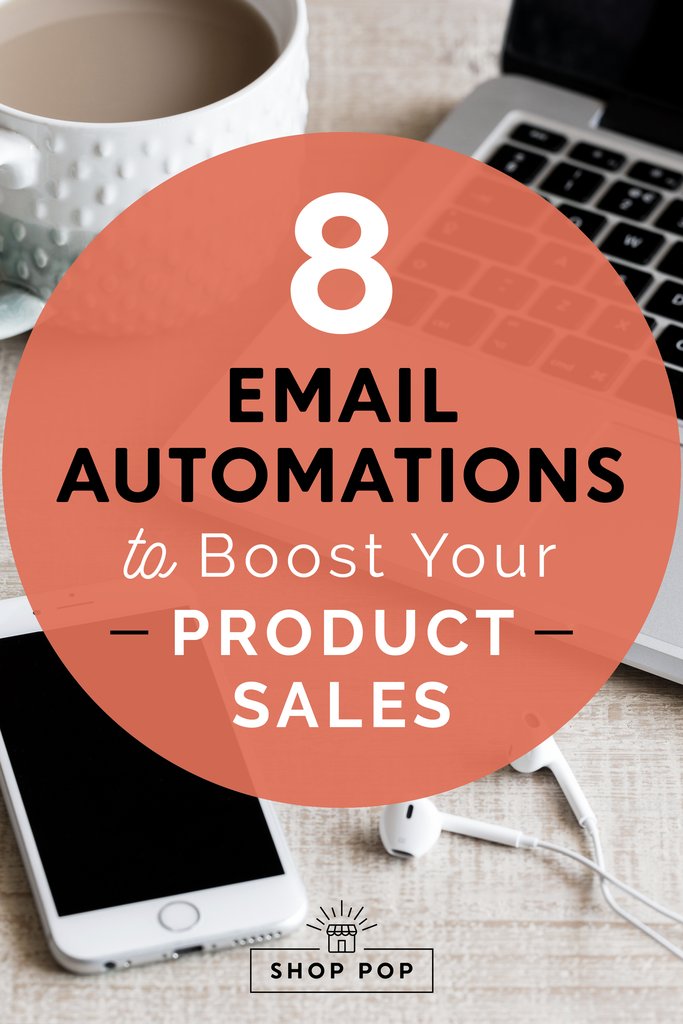
Email Automation #1: The Welcome Series
The first email automation every e-commerce shop needs is a welcome email or sequence.
A welcome email is triggered when someone new joins your list. And it one of the most highly opened emails you will ever send.
So what should you include in your welcome sequence to get the most out of this attention?
First, you should deliver any incentive you promised.
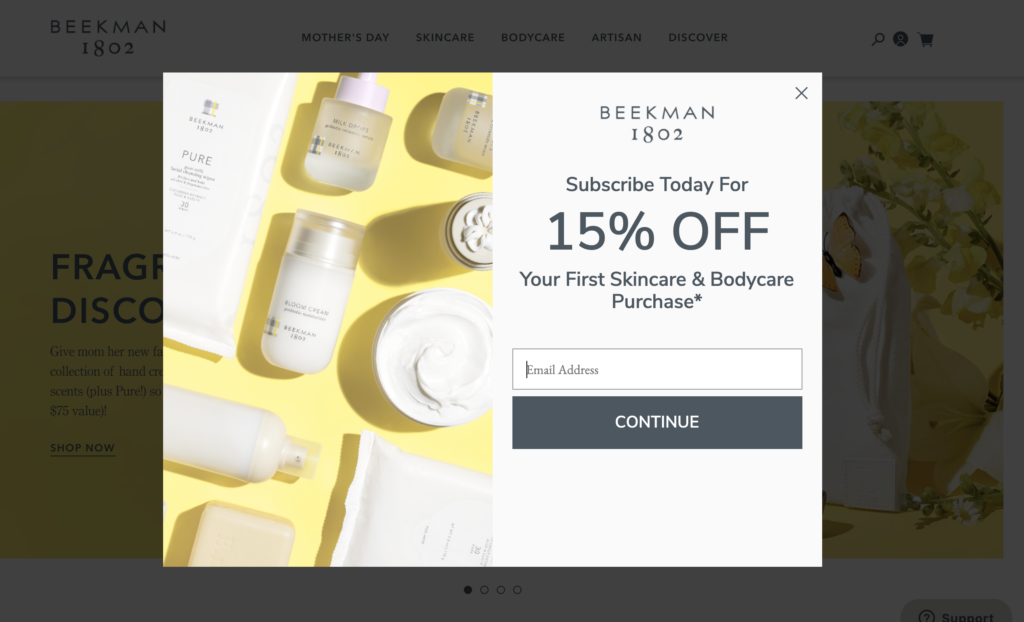
via Beekman 1802
Most product sellers offer some sort of financial incentive like 15% off or free shipping to join their list.
Your new subscriber is expecting to receive their offer right away, so be sure to include it in the first communication they get from you. Here’s an example from Kate Spade.

Secondly, your first email should actually welcome your subscriber to the club. Tell them about your brand story, mission (keep it short!), and how you intend to serve them and make their life better.
For a small business, I like to make this brand introduction a letter from the founder and include a picture signature. This is a personal touch that bigger brands often can’t offer. Here’s an example from Havenly.

You can also use your welcome sequence to give a “shop tour”. Think of yourself as a sales associate in a retail shop. Use product imagery to point out large categories or best sellers so your potential customer knows exactly where to find what she’s looking for. Here’s an example from Fossil.
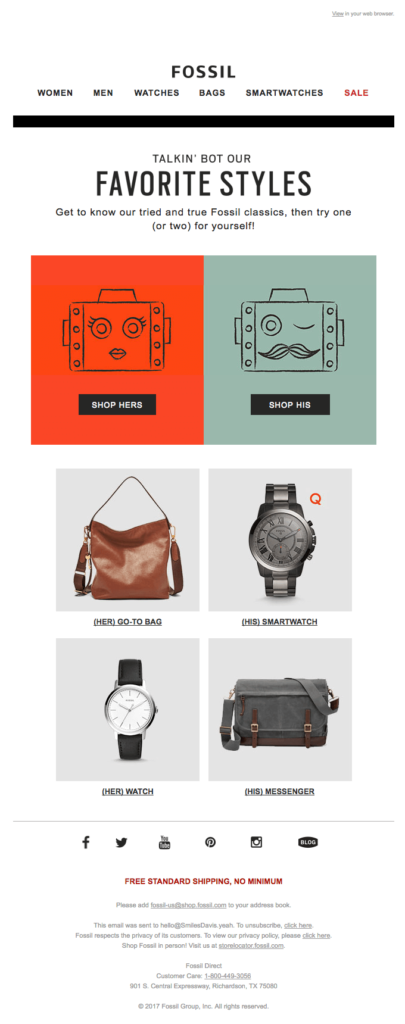
Many product sellers will end the welcome sequence after just one email. And that’s fine! But if your email service provider is connected to your website, you’ll also be able to send a followup.
Specifically, you’ll want to send a followup email to anyone who received your incentive (i.e. 15% off their purchase), but didn’t redeem it.
Use the second email to remind them that their offer is waiting on them and about to expire (if you had a time limit on it). Point out customer favorites, best sellers, or unique features, to make your potential customer feel confident about her first purchase.
Email Automation #2: Birthday Reward
A birthday reward automation is one that you set up to send a few days before your subscriber’s birthday. These are particularly powerful (and highly opened) because of their relevance to the subscriber. And who doesn’t like birthday gifts?
People tend to be in a “treat yourself” mood around their birthday, so this is the perfect time to encourage a little splurge.
Product based business owners can use this opportunity to offer their audience something small for free, and/or give them an incentive to spend money in their shop like X% off or $Y off any purchase. Here’s an example from Gap.
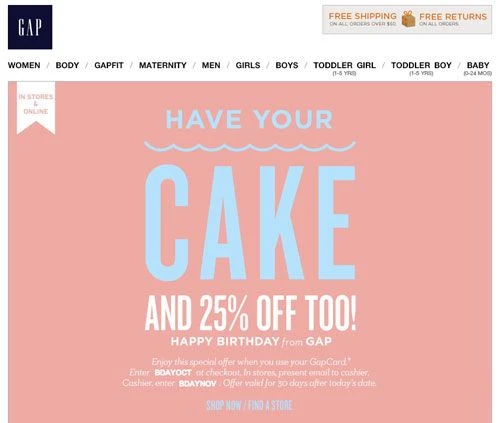
In order to run this automation, you will need your subscriber’s birthday. You can make collecting this info a field on your popup form. Or you can create a birthday collection embed form (via Klaviyo or your ESP) on your website.
Email Automation #3: Abandoned Cart
Did you know that about 70% of carts are abandoned?
That’s a lot of potential sales. And an abandoned cart automation tries to win them back before they’re gone for good.
A standard abandoned cart is sent to a customer a few hours after they left your site without finishing their purchase. The email should include images of the items in their cart and a link to “reclaim” them and pick up right where they left off. Here’s an example from Madewell.
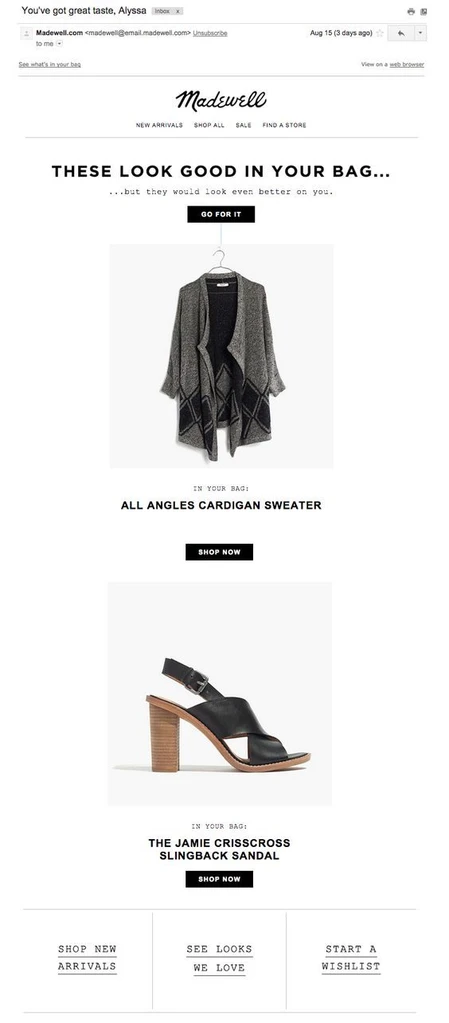
If you know why customers often abandon their carts, you can address those objections in your email, too.
For instance, if your customers feel uncertain about a certain aspect of your product or process, you can provide a link to your FAQ page or a customer service contact.
Or if you know price or shipping costs is what stands in the way, you can offer a financial incentive to remove that barrier.
Email Automation #4: Winback Email
A winback email or series is an automation sent to people who have purchased from you in the past but have not purchased from you in a certain amount of time.
Because it’s much cheaper to keep a current customer than to acquire a new one, most winback series offer the subscriber some financial incentive to come back and shop. Here’s an example from Brit + Co.
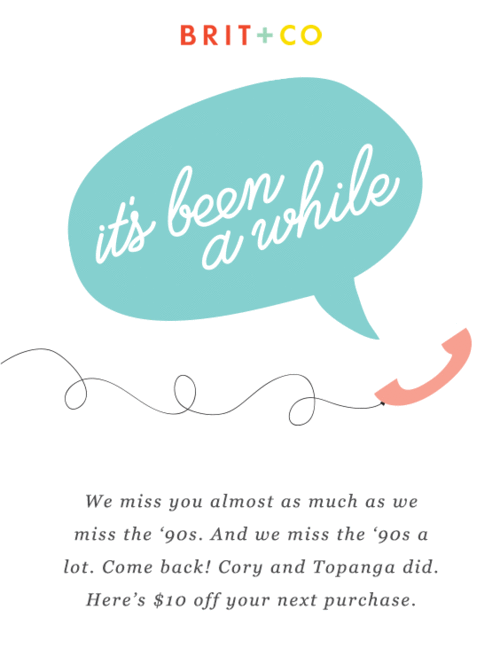
In the automation, tell the subscriber that you miss them, offer the incentive, and show them recent products they might have missed.
The length of time you wait to send this email depends on your buyer’s journey. For instance, a mattress company would likely send this email 3-4 years after a customer has not purchased, while a clothing company might send this after 3-4 months of no purchases.
Email Automation #5: Post-Purchase Followup
A post-purchase automation is one that you send to a customer after they make a purchase from you.
The point of this email is not to make a new sale, but to get your customer excited about their purchase. (This is especially important for online businesses where the customer has a wait time between purchase and delivery.) Here’s an example from FitBit.
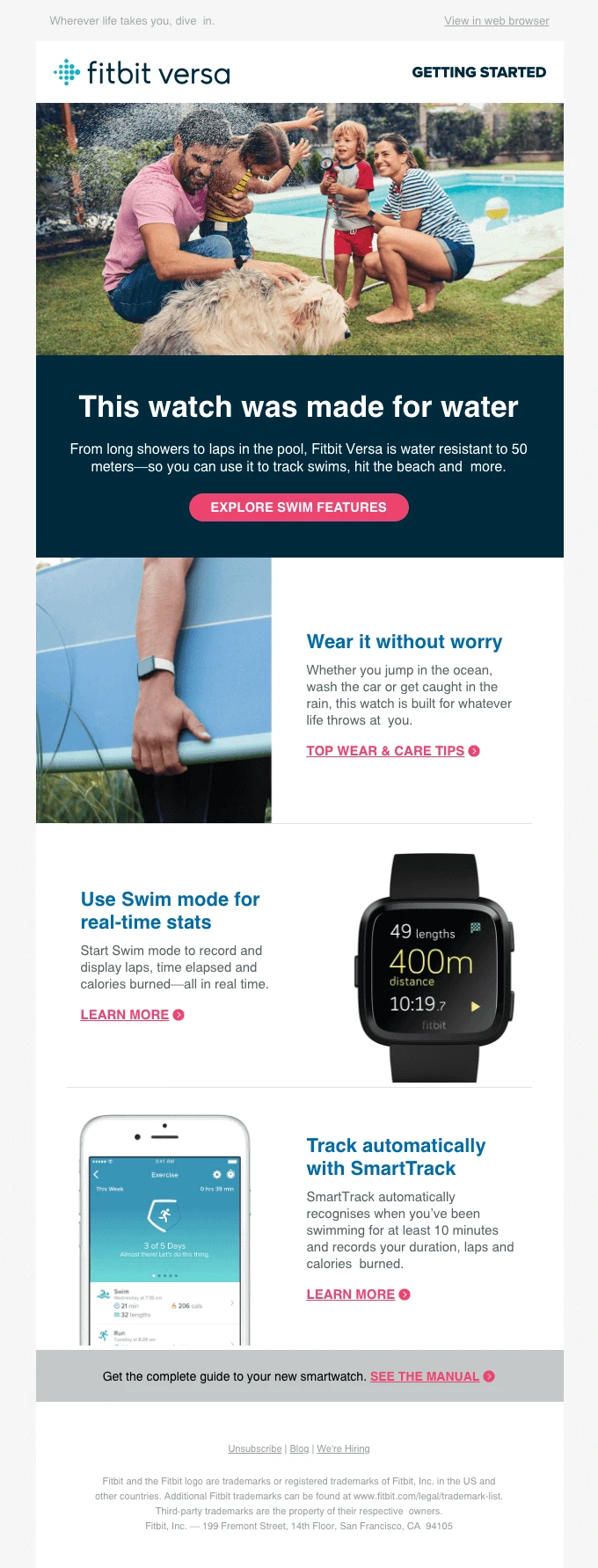
Use this email to say a hearty thank you and offer any resources that will make them love using their product even more.
For instance, if you sell natural bath products you could:
- Remind them of the benefits they will enjoy by using naturals products.
- Send a link to a blog post with ideas on how to make self-care part of their daily routine.
- Tell them how they can recycle/repurpose their product containers when the product is gone.
Email Automation #6: Cross-Sell Email
A cross-sell email suggests additional items based on the customer’s previous purchase.
These are particularly effective because they are more relevant to a customer’s preferences than a general newsletter campaign. Here’s an example from Dollar Shave Club.

The easiest way to start this automation is to think about what two or three items in your shop make a great pairing. Set up your automation to send if a customer buys product A but not product B or C.
For instance, if your customer bought a pajama set from you, but not a pair of slippers or a robe, use the cross-sell email to suggest these related products.
Email Automation #7: Reward Best Customers
A customer reward automation email is sent to build relational capital between you and your customers.
You can set this up to send after someone makes a certain number or purchases or after they spend a certain amount. Here’s an example from La Mer.

In the email, you can choose to either write a letter of thanks from the owner as a gesture of goodwill and gratitude. Or you can reward them for their loyalty with a special discount.
Either way, acknowledging your customer’s dedication to your brand is key to cementing a long-term relationship.
Email Automation #8: Review Request
Finally, after your customer has received their purchase and has had a few days to enjoy it, send them a request to review the product. Here’s an example from Casper.
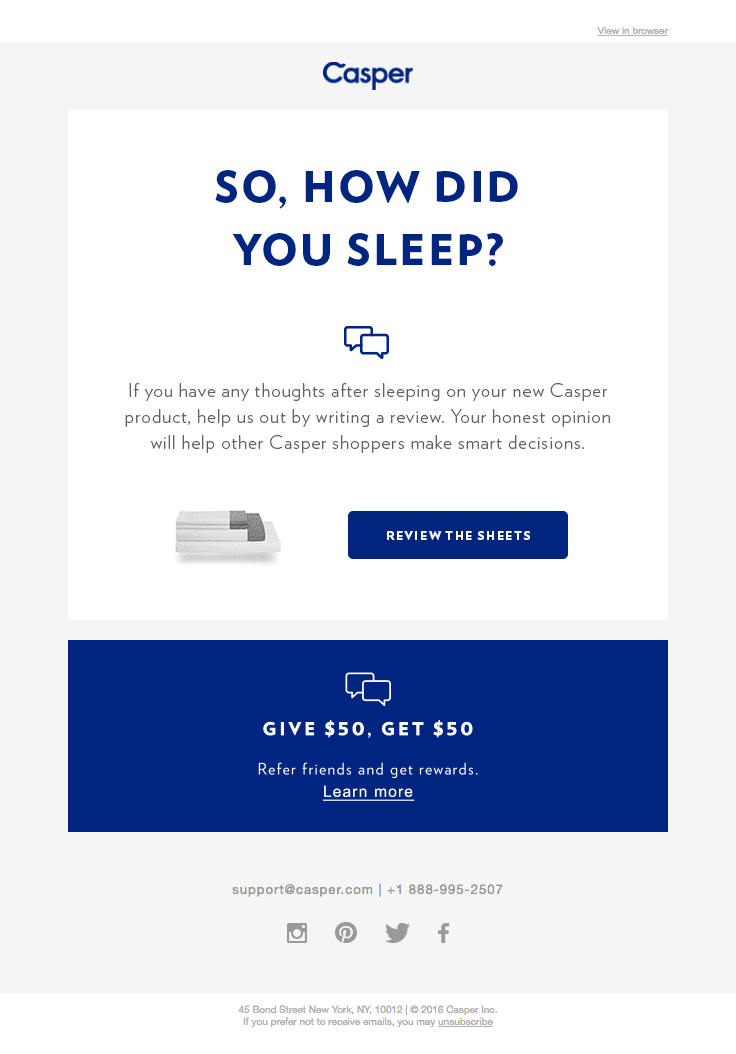
Social proof is very important for online shopping so you want to collect as many reviews as possible in order to give new buyers confidence in your products.
If you are using Shopify, an app like Judge.Me is great for collecting and publishing reviews on your site.
Final Thoughts on Email Automations for E-commerce Shops
Email Automatons for a product-based business are a no-brainer for growth. Their relevant content and timeliness will make them the star of your email marketing program.
If you’re ready to punt it to the professionals, check out our Automation Kickstart, and we’ll get your flows flowing.
+ show Comments
- Hide Comments
add a comment